Ultrasonic cleaning technology and application
Browse Volume:2087 Classify:Support
About “Ultrasonic Cleaning”
1. What is Ultrasound
Ultrasonic is a sound wave with a frequency higher than 20000 Hz. It has good direction, strong penetrating ability, easy to obtain concentrated sound energy, and travels far in water. It can be use for distance measurement, speed measurement, cleaning, welding, gravel, sterilization and disinfection Wait. There are many applications in medicine, military, industry and agriculture. Ultrasound is so name because its lower frequency limit is approximately equal to the upper limit of human hearing.
2. Two main parameters of ultrasonic
①Frequency: F220KHz (In practical application, the sound wave of F215K is also call ultrasonic wave because the effect is similar);
②Power density: p=transmitting power (W)/transmitting area (cm2); usually p>0.3w/cm2; the ultrasonic wave propagating in the liquid can clean the dirt on the surface of the object. And the principle can be use “cavitation” phenomenon. To explain: when the sound wave pressure propagated by ultrasonic vibration in the liquid reaches an atmospheric pressure. Its power density is 0.35w/cm2. At this time, the peak value of the sound wave pressure of the ultrasonic wave can reach vacuum or negative pressure. But in fact no negative pressure exists, so a large pressure is generate in the liquid. And the liquid molecules are pull apart into a cavity – a cavitation core. This cavity is very close to a vacuum. It ruptures when the ultrasonic pressure reverse reaches its maximum. And the strong impact caused by the rupture knocks the dirt off the surface of the object. This shock wave phenomenon cause by the bursting of countless tiny cavitation bubbles is call “cavitation” phenomenon. Too little sound intensity cannot produce cavitation effects.
3. Principle of ultrasonic cleaning
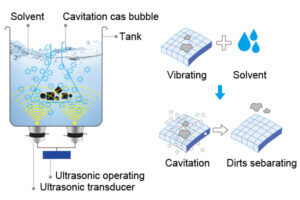
Ultrasonic principle
The ultrasonic application principle of cleaning is that the high-frequency oscillation signal emit by the ultrasonic generator is convert into high-frequency mechanical oscillation by the transducer and propagate to the medium. And the ultrasonic waves in the cleaning solvent are radiate forward in the cleaning solution. When the sound pressure reaches a certain value, the bubbles grow rapidly and then close suddenly. A shock wave is generate. Thousands of atmospheric pressures are generate around it. And the insoluble dirt is destroy and disperse in the cleaning solution. When the aggregate particles are wrap in oil dirt and adhere to the surface of the cleaning piece. The oil is emulsify and the solid particles are separate. So as to achieve the purpose of cleaning the surface of the cleaning parts.
4. Advantages of using ultrasonic cleaning
Compared with other cleaning methods, it shows great advantages. Especially in specialized and group-based production enterprises. Ultrasonic cleaning machines have gradually replaced traditional dipping, brushing, pressure washing, vibration cleaning and cleaning. Process methods such as steam cleaning, the high efficiency and high cleanliness of the ultrasonic cleaning machine are due to the penetration and cavitation impact generated when the sound wave propagates in the medium. So it is easy to have complex shapes, inner cavities and Clean the thin and hollow parts.
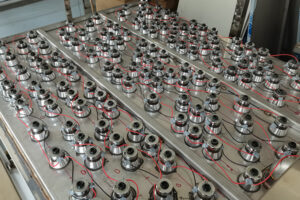
Transducer
For general degasing, rust prevention and other processes. It only takes two or three minutes to complete under the action of ultrasonic waves. And the speed can be several times or even dozens of times higher than traditional methods. The cleanliness can also reach a high standard. Which highlights the results that are difficult to achieve or irreplaceable by other processing methods in many occasions that require high product surface quality and productivity.
5. Technical characteristics
a.The cleaning effect is good, the cleanliness is high and the cleanliness of all work pieces is consistent.
b.The cleaning speed is fast, the production efficiency is improve, and no manual contact with the cleaning liquid is require, which is safe and reliable.
c.It can also clean deep holes, slits and hidden parts of work pieces.
d.No damage to the surface of the work piece, saving solvent, heat, workplace and labor.
The ultrasonic cleaning method
The ultrasonic cleaning method exceeds the conventional cleaning method. Especially the surface of the work piece is more complicated. Such as some mechanical parts with uneven surfaces and blind holes, and some products that are particularly small and have high requirements on cleanliness. Such as: Watches and precision machinery parts, electronic components, circuit board components, etc. Can achieve ideal results using ultrasonic cleaning. The principle of ultrasonic cleaning is that the high-frequency oscillation signal emitted by the ultrasonic generator is converted into high-frequency mechanical oscillation by the transducer and propagated to the medium-cleaning solvent. The flow produces tens of thousands of tiny air bubbles.
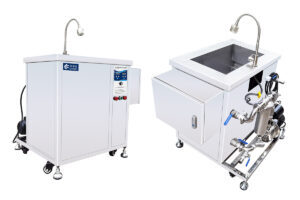
Granbosonic ultrasonic dishes cleaner
These bubbles form and grow in the negative pressure zone where ultrasonic waves propagate longitudinally. And close rapidly in the positive pressure zone. In this process known as the “cavitation” effect. The closing of the bubble can form an instantaneous high pressure of more than 1000 atmospheres. And the instantaneous high pressure is continuously generated. Just like a series of small “explosions” constantly impacting the surface of the object. Causing the surface of the object to And the dirt in the crevices peels off quickly, so as to reach the purpose of cleaning the surface of the object.
The mechanism of ultrasonic cleaning
Mainly includes the following aspects: a strong shock wave is generated when the cavitation bubble bursts. And part of the dirt layer is peeled off, dispersed, emulsified and peeled off under the action of the shock wave. Because of the bubbles generated by the cavitation phenomenon. The gaps and voids between the dirt layer and the surface layer formed by the impact penetrate.
The peeling-like physical force acts on the dirt layer repeatedly. The dirt layer is peeled off layer by layer. And the air bubbles continue to penetrate inward until the dirt layer is completely peeled off. This is the cavitation secondary effect. The impact of ultrasonic vibration of cleaning fluid on dirt in ultrasonic cleaning. Ultrasonic accelerates the process of dissolving dirt by chemical cleaning agent (RT-808 ultrasonic cleaning agent). And the combination of chemical force and physical force accelerates the cleaning process.
 Granbo Sonic
Granbo Sonic





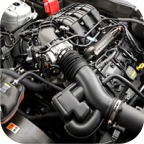



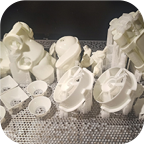





Hello!